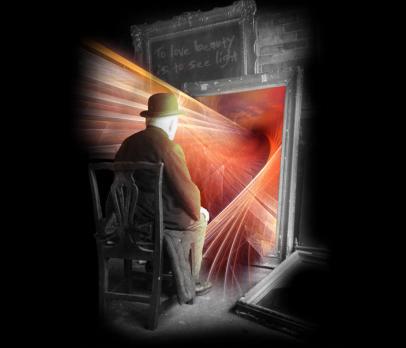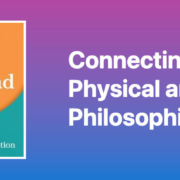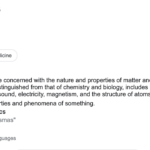The Postmodern Condition: Is it Fatal?
What we attempted to do with Theology Reconsidered, at least one of things we attempted to do, was to establish the intellectual framework, the rational grounds you might say, that underpins states of consciousness that broadly fall under the category of “altered”, what we termed supraconsciousness states that have been spoken of since time immemorial as a sort of unity consciousness experience for lack of a better term. In particular we study the life of Ramakrishna, who lived and preached in and around Calcutta in northern India in the 1850s, about 50 years after Kant, exploring the very boundaries of consciousness itself and whose life and experiences were documented by a handful of eyewitnesses, perhaps the most well documented mystic in history.
We root these states of consciousness in Indian philosophy, a system which naturally lends itself to the acceptance of such states of being, such states of realization as they are typically called. In a sense, Indian philosophy (orthodox) can be seen in a way as constructed around the firm belief in the fundamental reality of these states of consciousness. You could say the same about Buddhism, the most widespread of the heterodox Indian traditions. In Hindu mythos, these beings are called “avatars”, like Krishna for example, who are gods essentially that come down to Earth to teach humanity some important lesson specific to that Age. For Ramakrishna this was supposed to be the harmony of religions. In the Judeo-Christian tradition this is akin to what they call the messiah, although it is not the same thing necessarily. In the Hindu tradition these beings are God, in the Judeo-Christian tradition they are something different from God necessarily (think Trinity for example) – subtle but important distinction from an epistemological and ontological as well as theological perspective.
But we go beyond just philosophy in Theology Reconsidered, we also look to root this new science – the ageless truth that has been passed down since pre-history somehow, preserved in all of these ancient lineages and texts (if we but have the eyes to see and the ears to hear) – but also psychology as well, analyzing Ramakrishna’s spiritual practices and states of mind through both Jungian and Freudian lenses, which in turn draws clear lines between modern (Western) Psychology and Eastern philosophy more generally, as Jung came very close to doing but stopping short of a firm theoretical description of the infinite source – the collective unconscious and synchronicity in particular but also through the erotic, an idea we explore further here.
We take these seeds of thought then and follow them into a discovery of the basic framework of reality, through direct experience as much as validation from the ancient texts, which all contain seeds of this perennial philosophy somehow. We flesh out this basic metaphysics, a cosmogonic architecture that reveals itself to the author as he writes about it. This leads to the discovery of Homo Mysticus (ex machina), but that treatise focuses more on the way things came to be (cosmogony) and how this manifests physically in the world, following fundamental laws and properties that are described in mathematical and geometrical language, the so-called language of god.
The goal of Theology Reconsidered was to establish a bridge between this very ancient knowledge and Science, what we call (following Pirsig) the citadel of Science. Whether or not we are successful with that endeavor time will tell but this connection ultimately rests on a blended mystio-psychological-gnostic idea that we call the Awareness, a topic which we have explored further in this work. In a nutshell this idea is constructed out of, as a result of, Kant’s metaphysics more or less, with an ontological argument used to establish the existence of a cognitive ground, a substance without form in the Aristotelian sense, which underpins this entire reality, this entire world or universe as we know it. This is what we call Awareness, and it is all around us and everywhere at the same time, through which we have come to exist and experience existence, which in the final analysis we are non-different from.
What we look to do in Theology Reconsidered then is to establish an intellectual framework that bridges not just Physics, or Theology, but also Psychology, Biology, Computer Science, and Cognitive Science, as well as Philosophy proper – with a particular focus on metaphysics and ontology in an attempt to re-connect knowledge, Science, more broadly into a single framework of knowledge, as this word was conceived by the most ancient of philosophers in the Western tradition, Aristotle in particular.
This exercise puts us in a position then to look at Kant’s philosophical project as it relates to the question of how the world really is versus how we believe it to be, what has now arguably become one of the most important divisions in the Western philosophical tradition, not just in terms of how Kant is to be interpreted but the interpretation of Analytical philosophy in general. Along the way we re-cast Aristotelian philosophy in modern terms and argue strongly for a return to notion of science, knowledge, and first philosophy in Aristotelian terms.
It turns out we did part of that work, but not all of it. Something was left unfinished, particularly with respect to metaphysics generally but also more specifically with how precisely Kant’s metaphysics must be (re)shaped in order to account for the broadening of perspective, definitionally and scientifically, that we propose. While the Metaphysics of Awareness bridges the academic gap horizontally – between disciplines – it doesn’t go far enough within Philosophy proper to clarify some of the basic tenets of metaphysical inquiry as it is currently understood in the Western philosophical tradition.
And it’s this intellectual edifice, Western philosophy, that in fact not only underpins the scientific disciplines in the Academy, Science itself as we have come to understand it no less, but the one that is taught to us from childhood up through University and has come to represent a sort of an unassailable prevailing wisdom – a prevailing wisdom which sits in contrast to what we know about Physics today, as well as Psychology and Cognitive Science, a truth which is and has been known by poets and musicians and mystics alike since before the dawn of history. A truth that Pirsig so deftly points out in Zen and the Art of Motorcycle Maintenance sits at the very heart of Science itself, that the scientific method itself calls for not just the adaption of theory based upon experimental results, but rests on, whose success had been driven by, a sort of divine inspiration of theory, flashes of understanding from above – think Newton and the apple. How is this seemingly contradictory truth to be reconciled? This is what Pirsig attempts to do of course with his Metaphysics of Quality, a system we lean on somewhat here to flesh out some of the core metaphysical structures which we establish as the basis not just for thought, and mind (in the Kantian sense), but for “reality” itself as an ontological first principle of Being.
Our task was incomplete then – we had some hard slogging in Philosophy we needed to do to not just validate some of the initial findings and design of the (philosophical) systems we come up with in Theology Reconsidered and Homo Mysticus, but also root our metaphysics deeper into the Western philosophical tradition, finish the proverbial bridge, so that the edifice was stable enough, strong enough, to both save Western philosophy itself (which desperately needs saving IMO) and at the same time provide a more analytical, more “scientific”, framework within which Eastern philosophy more generally could be understood.
We thought we had slain the dragon, but we had merely wounded it as it turns out.
So here we are back again, armed with more books and the Internet, the most massive and well-functioning library that has ever been constructed, and this massive machine, computer with all these fancy monitors and this fancy software that allows me to transmit these thoughts, these words, as they come into my head onto this page about a topic that philosophers, theologians and intellectuals have been arguing about no doubt since they learned to argue. Philosophical debate is endless, of this much I am certain. But we must enter the fray, if for no other reason than to see if our system stands to reason (pun intended).
Spoiler alert: we believe it does
But also, as we dust off some of these ideas once again, explore their depths further, we have around us a sort of collapse of Western culture that is alarming. And this collapse, although perhaps maybe transition is a better word, is driven in part by a (continued) warping of the Western philosophical tradition, fueled by the Academy, that falls broadly under the heading of postmodernism, which in turn has a close connection with critical race theory (CRT), which mirrors – in the United States in particular – a general distrust and disappointment with the current state of society, reflected markedly by the incidents of unrest that are almost a daily occurrence now.
That postmodernism is indefinable is a truism. However, it can be described as a set of critical, strategic and rhetorical practices employing concepts such as difference, repetition, the trace, the simulacrum, and hyperreality to destabilize other concepts such as presence, identity, historical progress, epistemic certainty, and the univocity of meaning. [1]
We must ask the question however, given this propensity to question everything now, to assume that any structure of power is corrupt, by nature – are the philosophical foundations of postmodern thought truly coherent? Or are they missing something fundamental that renders their conclusions dubious at best? [2]
In other words, if we believe (as these philosophical traditions systems profess to tell us, nay teach us) that all power structures are corrupt, that truth and justice are simply tools of the powerful, and that essentially the human being is a power seeking being at its core, we should like to think that a) these conclusions rest on truly rational grounds that stand up to philosophical criticism and b) if they don’t, that the necessary corrections, and implications therein, are properly understood so that the system’s limitations are clarified– giving at least a chance for the academy to correct its ways (perhaps).
In the current environment this seems like a hail-Mary pass at the very end of the game but over time the pendulum always swings so better to have the work done and of use that accepting defeat at this point. At least so goes the thinking.
It turns out, there does exist a sort of metaphysical mistake that was made in the Western philosophical tradition from which a line to these false conclusions, basic misconceptions can be drawn. Misconceptions that, like almost all thought in Western Philosophy post-Kant, rest on Kantian foundations (even if those foundations are how you disagree with him, we’re all post Kantians whether we see each other in this light or not). For it is with Kant that we lay the foundations for not moral relativism necessarily, but perhaps more insidiously, an epistemological relativism that comes along with the acceptance of his new metaphysics as not just a science of metaphysics but the science of metaphysics.
For a natural conclusion to be drawn about knowledge that sits outside of this Kantian metaphysical framework, for example the world as it is, is that if its conception lays outside of this domain more or less, it must be not just treated with skepticism, but it cannot be known (for what it truly is) at all. Merely an opinion Kant might say, nothing more. Then, and this is the wrong turn really, when we combine this (Kantian) epistemological restriction with a fundamental misconception about what the world truly is – that we receive through Schopenhauer (Will) and then Nietzsche (Will to power) specifically – we end up with postmodern critical thought, as expressed through Foucault and others which calls into question not just knowledge, as Kant had, but the very foundations of society itself, that very thing that Kant was trying to so desperately save.
We will illustrate this mistake here and then, building on the work done in Theology Reconsidered primarily, look to flesh out our Metaphysics of Awareness further such that these basic deficiencies to postmodern philosophy are addressed, bringing together both the scientific foundations of the world as it appears and the world as it is in a more harmonious, more coherent and balanced framework that properly reflects our truly postmodern understanding of reality. That is, Metaphysics Reconsidered.
It is worth pointing out before we begin this exercise that from a philosophical perspective, using this term in the broadest sense, what we see unfolding in society and popular culture today is no different from how we view the development, evolution really, of advanced society in the last five thousand years – namely the adaptation of social, economic and political structures to prevailing, popular sentiment which are rooted in some core philosophical (or theological, the distinction of which is a modern invention) tenets, tenets and belief systems that change over time, adapting to different conditions – or perhaps better put arising out of specific conditions – and as such are reflected in changes to the basic socio-economic, and in turn political, structure of a society. We have a Darwinian, naturally selective view of the evolution of not just man, but the social structures within which man has evolved to which he is an instrumental part of, i.e. society at large you might call it.[3]
Furthermore these social structures, as organic structures, obey basic organic laws one of which is that states are usually jumped into and out of, a processes which either absorbs or releases energy.[4] As reflected in a complex society, this shift in energy states usually comes in the form of basic unrest (riots, bombings, shootings, violence, etc.) as people move, somewhat uncomfortably, from one state of consciousness or understanding of the world to another. This is what we are seeing in the United States now, and even more broadly in the West, because we are shifting perspectives, as a direct result of this shifting.
Resistance to change is in fact one of the great attributes of mankind, which has facilitated the development of such advanced societies – stability. But every once in a while, the foundations fail us and we must rebuild and a quantum shifting of consciousness occurs. We are in one of those right now. This work intends to help that rebuild process by laying the rational foundations for the new mode of thinking that we must adopt if we want to save our planet, save ourselves really, a mutually interdependent relationship that must be better understood and appreciated in order for this next phase of being to take firm roots. For better or worse it may take folks some time to catch up with me but it is the firm belief of the author at least that this work will have some value to society at large someday. I wouldn’t be writing if I didn’t.
This interplay between stabilized systems and hierarchies, critical thinking and adaptation, and updates and revisions of underlying socio-economic-political structures is what Robert Pirsig, in particular in this second book Lila, discusses in much detail. We cover this in detail in Theology Reconsidered and build on some of these themes in this work but essentially Pirsig’s Metaphysics of Quality rests on two competing notions that forever are in interplay and exchange with another – Static structures, that have grown over time and act as stabilizing forces (to whatever system that are governing), and a more fundamental Dynamic force at play that represent new ideas, inspired by the arts and social movements for example. Scientific method lines up squarely against this structure – with the theoretical structure (Static Quality) evolving as new ideas (Dynamic Quality) are hypothesized and explored and re-integrated into the overall body of knowledge through the Static Quality structures themselves – theoretical frameworks that are tested in order to evolve, forever moving closer to truth in the scientific realm.
In the socio-political realm it is more of an optimization problem – with culture persisting with little or no change until finally things get so out of balance that they shift quite suddenly to a new (hopefully higher, or more elevated) state of being, state of collective understanding or consciousness, based upon new and improved adapted Static structures that better reflect social sentiment and current conditions – geopolitically, naturally and otherwise. This is the myth of progress except it’s not progressive so much necessarily as it is continuously optimized for better outcomes, as defined by the system itself. This relationship can be seen quite clearly when the metaphysical reconstruction is complete – through Pirsig’s system or my own (which inherits aspects of his by communitive association). Social change then can be seen as following a similar model of change as sub-atomic theory, where sub-atomic “particles” (electrons, photons) shift from one discrete ‘state’ to another, and not gradually on a continuous line through linear time and space as we understand it. Psychological “breakthroughs” follow similar patterns. Jumps in athletic performance do as well, with it well known among pro athlete circles that improvements come in very big and sudden jumps with minimal improvement over long periods of time sometimes.
This is one of the most peculiar attributes, discoveries really, of the sub-atomic realm that it seemed to behave in a manner that was very very different than how we thought matter behaved as outlined primarily by Newton. This is the quantization aspect of Quantum Mechanics, that these electrons and other basic particles move into specific orbits (calculated as a function of Plank’s constant which bears the discoverer’s name), and as they shift, they either absorb or release energy, and energy is always conserved… and energy and matter are equivalent in some way, as a function of the speed of light… This is the world we live in. Stop and consider this for a moment. This is the world that we attempt to (better) describe with our Metaphysics of Awareness, what we ultimately call the science of transcendental realism.
Again we see the same type of behavior in complex societies, radical shifts in basic structure that arise out of, and rest on, an absorption of energy that is associated directly with the (extent and measure of the) shift. We see this playing out today, we also see it play out post Enlightenment (French and American Revolutions), also in the United States in the 60s during Vietnam and Watergate scandal. Countless examples exist actually. Real estate markets move in the same way, as do all equity markets, radical shifts in value in very rapid succession followed by years and sometimes decades of stability. This is one of the laws of nature, that is true at the very ground of nature herself, and manifests within higher order structures as they emerge from this lower order reality (as above so below, or in this case as below so above).
The fact that this law follows very basic core geometrical and mathematical formulas, based on universal constants in many cases, is quite the mystery in fact. This mystery we attempt to unravel in Homo Mysticus, but here we do not so much try and solve this mystery so much as to use it, through a more evolved system of understanding about reality itself, to better understand how this reality works. Next level engineering you might call it, or philosophical engineering. Or applied metaphysics perhaps. Regardless what you call it, there are some significant benefits to doing this properly, and well as it turns out and conversely some pretty dire side effects if done improperly, or poorly – as the Marxist experiments of the 20th century have taught us if nothing else (Russia, Germany primarily).
In the socio-political realm though these shifts are not driven by experiment, they are naturally occurring (social/collective) phenomena that, when they reach critical mass, force a change in the (Pirsig) Static structures that govern (various aspects of) society, driven by this (Pirsig) Dynamic force of unrest, or anxiety, which is a very real psychological phenomena which underpins the movement towards the new from the old. Propels it forward at the individual psychological level you could say, and then – usually stimulated by an incident or series of incidents out of which popular sentiment “boils over”, with the intellectual and symbolic structures of the movement having been firmly established (postmodernism and critical race theory), the shift in state occurs effectively. The philosophy, the mythos and theos, is what the movement latches onto in the new state to effectively stabilize. It can’t stabilize if it does not have the higher order framework to latch onto. The development of this framework, or at least its recognition and adoption, is what happens in order that the new state of being, socio-politically, can take hold.
We are in this quantum shifting phase of transition now. In the eye of the storm as it were. The tenuous nature of our current state of being, individually and collectively, is palpable. Every time you walk out of your house almost, no matter where you live in the United States. It was seen in the nation’s capital in the riots that ensued when we swore in our new President on Jan 6, 20201 (01-06-2021). This psychological unrest can also be seen manifested in all of the mass shootings we have here, that seem to be ubiquitous now, as well as the repeated killing of young black men by police officers in these seemingly endless tragedies that unfold almost in real time all across the world now for everyone to see. These killings now have come to represent the archetypical imagery of the movement for change that underpins Black Lives Matter, and its counter movements reflected in the rise of white nationalism sentiment.
For every force has an equal counterpart around which they evolve, like DNA strands, like planets, social movements are no different. Everything is seen, understood, in relation to something else (hence our argument for Awareness underpinning Kantian metaphysics). Black is the opposite of white, it is understood in that way in a very real sense, as is white in relation to black. For a new society to emerge, it must be built off of, from and out of, but nonetheless an improvement upon, the old. Out if it’s ashes you could say.
We explore here some of the philosophical underpinnings of these movements for change, point out where they have gone astray, and hopefully, if we have done our job right, articulate a more accurate and descriptive, and ultimately more practical (philosophical and metaphysical model) for us to move forward with so that the baby is saved from the proverbial ditching of the bathwater.
Everyone loves babies right?
[1] Aylesworth, Gary, “Postmodernism”, The Stanford Encyclopedia of Philosophy (Spring 2015 Edition), Edward N. Zalta (ed.), URL = <https://plato.stanford.edu/archives/spr2015/entries/postmodernism/>.
[2] For a great primer on what these intellectual movements are and how they inter-depend on each other, see https://gentlereformation.com/2020/06/18/marxism-postmodernism-and-critical-race-theory/.
[3] And theology and philosophy more generally. These intellectual structures evolve as a function of social complexity essentially, or ontological complexity really.
[4] As my wife points out, when subatomic particles change state they can either go to a lower energy level, where they release (commensurate) energy, or to a higher energy level after absorbing energy, as measured by the components together in that quantum mechanical system. Energy is always conserved basically.










I have re-read this to read your later work on Kant….I remind myself that the real is messy, ill-defined and boundless… I am torn or straddling what you are saying alongside others like Henry Tam (see Question the Powerful) and Bojan Radej (see Complex Society, In the Middle of The Middle World)… the dense and tough ground covered requires that great steps are taken…. and because of this I feel an angst…. thoughtful work and on such a scale too…
It’s a long and winding road for sure, the subject of my latest work that just went to the publisher, of which this essay is a part. It can be unraveled with a little persistence though, and this is necessary to move our understanding of metaphysics forward. Kant draws attention to the relationship between what might be called fundamental beliefs (a priori cognitions) but fails to see what these are with reference to his own work somewhat ironically.
there’s a block, I think, in the conceptualisation of the voids I have literally just stumbled over this https://the conversation.com/three-female-philosophers-you’
sorry my device is not working properly see
https://the conversation.com/three-female-philosophers-you’ve-probably-never-heard-of-in-the-field-of-big-consciousness-126974